
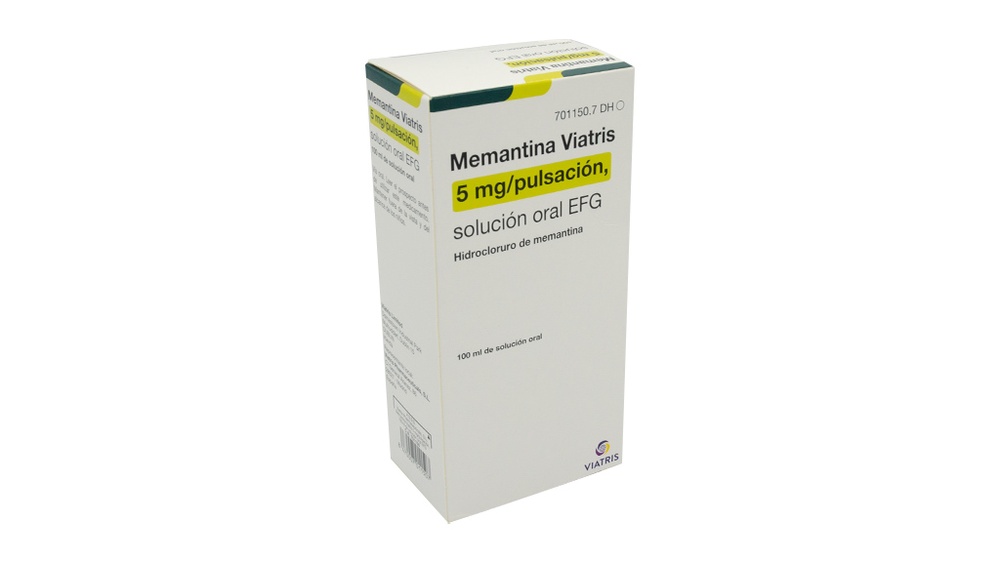
МЕМАНТИНА ВИАТРИС 5 мг/доза ОРАЛЬНЫЙ РАСТВОР

Спросите врача о рецепте на МЕМАНТИНА ВИАТРИС 5 мг/доза ОРАЛЬНЫЙ РАСТВОР

Инструкция по применению МЕМАНТИНА ВИАТРИС 5 мг/доза ОРАЛЬНЫЙ РАСТВОР
Введение
ПРОСПЕКТ: ИНФОРМАЦИЯ ДЛЯ ПОЛЬЗОВАТЕЛЯ
Мемантин Виатрис 5 мг/пульсация, раствор для приема внутрь ЕФГ
Гидрохлорид мемантина
Прочитайте внимательно весь листок-вкладыш перед началом приема этого лекарства, поскольку он содержит важную информацию для вас.
- Сохраните этот листок-вкладыш, поскольку вам может понадобиться прочитать его снова.
- Если у вас есть какие-либо вопросы, проконсультируйтесь с вашим врачом или фармацевтом.
- Это лекарство было назначено вам, и его не следует давать другим людям, даже если у них такие же симптомы, как у вас, поскольку оно может нанести им вред.
- Если вы испытываете побочные эффекты, проконсультируйтесь с вашим врачом или фармацевтом, даже если это возможные побочные эффекты, которые не указаны в этом листке-вкладыше. См. раздел 4.
Содержание листка-вкладыша:
- Что такое Мемантин Виатрис и для чего он используется
- Что вам нужно знать перед началом приема Мемантин Виатрис
- Как принимать Мемантин Виатрис
- Возможные побочные эффекты
- Хранение Мемантин Виатрис
- Содержание упаковки и дополнительная информация
1. Что такое Мемантин Виатрис и для чего он используется
Мемантин Виатрис содержит гидрохлорид мемантина в качестве активного вещества. Он принадлежит к группе лекарств, известных как противодементные лекарства.
Потеря памяти при болезни Альцгеймера обусловлена нарушением сигналов мозга. Мозг содержит так называемые рецепторы N-метил-D-аспартата (NMDA), которые участвуют в передаче важных нервных сигналов, связанных с обучением и памятью. Мемантин Виатрис принадлежит к группе лекарств, называемых антагонистами рецепторов NMDA. Мемантин Виатрис действует на эти рецепторы, улучшая передачу нервных сигналов и память.
Мемантин Виатрис используется для лечения пациентов с болезнью Альцгеймера средней и тяжелой степени.
2. Что вам нужно знать перед началом приема Мемантин Виатрис
Не принимайте Мемантин Виатрис
- Если вы аллергичны к гидрохлориду мемантина или к любому другому компоненту этого лекарства (перечисленному в разделе 6).
Предостережения и меры предосторожности
Проконсультируйтесь с вашим врачом или фармацевтом перед началом приема Мемантин Виатрис
- Если у вас есть истории эпилептических приступов.
- Если вы недавно перенесли инфаркт миокарда (атаку сердца), если у вас есть сердечная недостаточность или если у вас есть гипертония (высокое кровяное давление), не контролируемая.
В этих ситуациях лечение должно быть тщательно контролируемым, и ваш врач должен регулярно переоценивать клиническую пользу мемантина.
Если у вас есть почечная недостаточность (проблема с почками), ваш врач должен внимательно контролировать функцию почек и, если необходимо, корректировать дозы мемантина.
Не следует использовать мемантин вместе с другими лекарствами, такими как амантадин (для лечения болезни Паркинсона), кетамин (общий анестетик) и другие антагонисты NMDA.
Дети и подростки
Не рекомендуется использовать мемантин у детей и подростков моложе 18 лет.
Другие лекарства и Мемантин Виатрис
Сообщите вашему врачу или фармацевту, если вы принимаете, недавно принимали или можете принимать любое другое лекарство.
В частности, прием мемантина может изменить эффекты следующих лекарств, поэтому ваш врач может cần скорректировать дозу:
- Амантадин, кетамин, декстрометорфан.
- Дантролен, баклофен.
- Циметидин, ранитидин, процинамид, хинидин, хинин, никотин.
- Гидрохлортиазид (или любая комбинация с гидрохлортиазидом).
- Антихолинергические вещества (обычно используемые для лечения расстройств движения или кишечных спазмов).
- Противосудорожные вещества (используемые для предотвращения и устранения судорог).
- Барбитураты (обычно используемые для индукции сна).
- Допаминергические агонисты (вещества, такие как Л-допа, бромокриптин).
- Нейролептики (вещества, используемые в лечении психических заболеваний).
- Оральные антикоагулянты.
Если вы поступаете в больницу, сообщите вашему врачу, что вы принимаете Мемантин Виатрис.
Прием Мемантин Виатрис с пищей и напитками
Вы должны сообщить вашему врачу, если вы недавно изменили или планируете существенно изменить свою диету (например, с нормальной диеты на строгую вегетарианскую диету) или если у вас есть почечная тубулярная ацидоз (АТР, избыток кислотообразующих веществ в крови из-за почечной дисфункции) или тяжелые инфекции мочевыводящих путей, поскольку ваш врач может cần скорректировать дозу лекарства.
Беременность и лактация
Если вы беременны или кормите грудью, считаете, что можете быть беременной или планируете стать беременной, проконсультируйтесь с вашим врачом или фармацевтом перед приемом этого лекарства.
Беременность
Не рекомендуется использовать мемантин во время беременности.
Лактация
Женщины, принимающие мемантин, должны прекратить кормление грудью.
Вождение и использование машин
Ваш врач сообщит вам, позволяет ли ваше состояние вождению и использованию машин с безопасностью.
Кроме того, мемантин может изменить вашу реакцию, поэтому вождение или использование машин могут быть неуместными.
Мемантин Виатрис содержит сорбитол
Это лекарство содержит 36 мг сорбитола в каждом 0,5 мл, что эквивалентно 72 мг/мл.
.
3. Как принимать Мемантин Виатрис
Следуйте точно инструкциям по приему Мемантин Виатрис, указанным вашим врачом или фармацевтом. В случае сомнений проконсультируйтесь с вашим врачом или фармацевтом.
Дозировка
Пожалуйста, следуйте следующим инструкциям при использовании дозатора. Прилагаются схемы с необходимыми указаниями для правильного использования дозатора.
Одна пульсация содержит 5 мг гидрохлорида мемантина.
Рекомендуемая доза Мемантин Виатрис для взрослых пациентов и пациентов пожилого возраста составляет четыре пульсации дозатора, что эквивалентно 20 мг, принимаемым один раз в день. Чтобы уменьшить риск побочных эффектов, эта доза достигается постепенно, следующим по схеме ежедневного лечения:
Неделя 1 | Одна пульсация дозатора (эквивалентна 0,5 мл) |
Неделя 2 | Две пульсации дозатора (эквивалентны 1 мл) |
Неделя 3 | Три пульсации дозатора (эквивалентны 1,5 мл) |
Неделя 4 и последующие | Четыре пульсации дозатора (эквивалентны 2 мл) |
Обычная начальная доза составляет одну пульсацию (5 мг) один раз в день в первую неделю. Эта доза увеличивается во вторую неделю до двух пульсаций один раз в день (10 мг) и в третью неделю до трех пульсаций один раз в день (15 мг). Начиная с четвертой недели, рекомендуемая доза составляет четыре пульсации один раз в день (20 мг).
Дозировка для пациентов с почечной недостаточностью
Если у вас есть проблемы с почками, ваш врач решит, какая доза подходит для вашего состояния. В этом случае ваш врач должен периодически контролировать функцию почек.
Применение
Мемантин Виатрис должен применяться перорально один раз в день. Чтобы получить максимальную пользу от вашего лекарства, вы должны принимать его каждый день и в одно и то же время. Раствор следует принимать с небольшим количеством воды. Раствор можно принимать с пищей или без нее.
Для подробных инструкций по подготовке и обращению с продуктом см. конец этого листка-вкладыша.
Продолжительность лечения
Продолжайте принимать Мемантин Виатрис, пока это полезно для вас. Врач должен периодически оценивать эффекты вашего лечения.
Если вы приняли больше Мемантин Виатрис, чем следует
- В случае передозировки или случайного приема проконсультируйтесь немедленно с вашим врачом или фармацевтом или позвоните в Службу токсикологической информации, телефон 91 562 04 20, указав лекарство и количество, принятое.
- В целом, прием избыточного количества Мемантин Виатрис не должен нанести вам вреда. Вы можете испытать увеличение симптомов, описанных в разделе 4 «Возможные побочные эффекты».
Если вы пропустили прием Мемантин Виатрис
Если вы поняли, что пропустили дозу Мемантин Виатрис, подождите и примите следующую дозу в обычное время. Не принимайте двойную дозу, чтобы компенсировать пропущенную дозу.
Если у вас есть какие-либо другие вопросы о использовании этого лекарства, проконсультируйтесь с вашим врачом или фармацевтом.
4. Возможные побочные эффекты
Как и все лекарства, это лекарство может вызывать побочные эффекты, хотя не все люди испытывают их.
В целом побочные эффекты классифицируются от легких до умеренных.
Частые (могут повлиять до 1 из 10 человек):
- Головная боль, сонливость, запор, повышенные показатели функции печени, головокружение, нарушение равновесия, затруднение дыхания, высокое кровяное давление и гиперчувствительность к лекарству.
Редкие (могут повлиять до 1 из 100 человек):
- Усталость, грибковые инфекции, путаница, галлюцинации, рвота, нарушение походки, сердечная недостаточность и образование тромбов в венозной системе (тромбоз/тромбоэмболия).
Очень редкие (могут повлиять до 1 из 10 000 человек):
- Судороги.
Частота неизвестна (частота не может быть оценена из доступных данных):
- Панкреатит, гепатит и психотические реакции.
Болезнь Альцгеймера связана с депрессией, суицидальными мыслями и суицидом. Были зарегистрированы случаи этих событий у пациентов, леченных мемантином.
Сообщение о побочных эффектах
Если вы испытываете любой побочный эффект, проконсультируйтесь с вашим врачом или фармацевтом, даже если это возможные побочные эффекты, которые не указаны в этом листке-вкладыше. Вы также можете сообщить о них напрямую через Систему фармаковигиланса лекарств для человека: https://www.notificaram.es. Сообщая о побочных эффектах, вы можете внести свой вклад в предоставление более полной информации о безопасности этого лекарства.
5. Хранение Мемантин Виатрис
Храните это лекарство в недоступном для детей месте.
Не используйте это лекарство после даты истечения срока годности, указанной на коробке и этикетке флакона после CAD или EXP. Дата истечения срока годности - последний день месяца, указанного.
Это лекарство не требует особых условий хранения.
После открытия содержимое флакона должно быть использовано в течение 12 недель.
Флакон с установленным дозатором должен храниться и перевозиться только в вертикальном положении.
Лекарства не следует выбрасывать в канализацию или мусор. Поместите упаковку и лекарства, которые вам больше не нужны, в пункт SIGRE аптеки. Если у вас есть сомнения, проконсультируйтесь с вашим фармацевтом о том, как избавиться от упаковки и лекарств, которые вам больше не нужны. Таким образом, вы поможете защитить окружающую среду.
6. Содержание упаковки и дополнительная информация
Состав Мемантин Виатрис
Активное вещество - гидрохлорид мемантина.
Каждая пульсация дозатора выпускает 0,5 мл раствора, содержащего 5 мг гидрохлорида мемантина, эквивалентного 4,16 мг мемантина.
Каждый мл раствора содержит 10 мг гидрохлорида мемантина.
Другие компоненты - сорбат калия Е-202, жидкий сорбитол (бескристаллический) (Е-420) и очищенная вода.
Внешний вид продукта и содержание упаковки
Мемантин Виатрис раствор для приема внутрь - прозрачный, бесцветный или слегка желтоватый раствор.
Мемантин Виатрис раствор для приема внутрь выпускается в флаконах по 50 мл, 100 мл или 10 х 50 мл.
В комплекте идет дозатор.
Возможно, не все размеры упаковки будут продаваться.
Владелец разрешения на маркетинг
Виатрис Лтд.
Дамастаун Индустриал Парк
Мулхуддарт, Дублин 15
Дублин
Ирландия
Производитель
Чанель Медикал Анлимитед Компани
Дублин Роуд, Лоугреа, Ко. Голуэй,
Ирландия
Вы можете запросить дополнительную информацию о этом лекарстве, обратившись к местному представителю владельца разрешения на маркетинг:
Виатрис Фармацевтикалс, С.Л.У.
К/ Генерал Аранас, 86
28027 - Мадрид
Испания
Это лекарство разрешено к продаже в государствах-членах Европейского экономического пространства под следующими названиями:
Германия Мемантинхидрохлорид бета 10 мг/мл раствор для приема внутрь
Италия МЕМАНТИНА ДОК
Испания Мемантин Виатрис 5 мг/пульсация, раствор для приема внутрь ЕФГ
Нидерланды Мемантин 10 мг/мл напиток
Великобритания Мемантин Гидрохлорид 10 мг/мл пероральный раствор
Словакия Мемантин Чанель 10 мг/мл пероральный раствор
Дата последнего пересмотра этого листка-вкладыша:май 2021
Подробная информация о этом лекарстве доступна на сайте Агентства по лекарствам и медицинским изделиям Испании (AEMPS) http://www.aemps.gob.es/
Инструкции для правильного использования дозатора
Раствор не должен наливаться или дозироваться непосредственно в рот из флакона или дозатора. Измерьте дозу в ложке или в стакане с водой, используя дозатор.
Снимите крышку с флакона:
Крышка должна быть повернута против часовой стрелки, полностью снята и удалена (рис. 1).
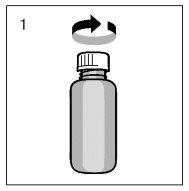
Установка дозатора на флакон:
Выньте дозатор из пластикового пакета (рис. 2) и поместите его на флакон. Аккуратно вставьте пластиковую трубку в флакон. Держите дозатор на горлышке флакона и поверните по часовой стрелке до тех пор, пока он не будет надежно закреплен (рис. 3). Дозатор должен быть завинчен только один раз при начале использования и никогда не должен быть отвинчен.
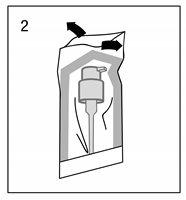
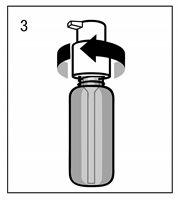
Как работает дозатор:
Головка дозатора имеет две позиции и легко поворачивается:
- против часовой стрелки, чтобы открыть, и
- по часовой стрелке, чтобы закрыть.
Головка дозатора не должна быть нажата вниз, пока она находится в закрытом положении. Раствор можно дозировать только в открытом положении. Чтобы открыть, поверните головку дозатора в направлении, указанном стрелкой, до тех пор, пока она не может быть повернута дальше (около одной восьмой поворота, рис. 4). Дозатор теперь готов к использованию.
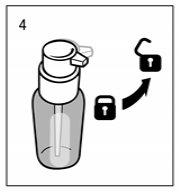

Подготовка дозатора:
Когда вы используете его впервые, дозатор не дозирует правильное количество раствора для приема внутрь. Следовательно, его необходимо подготовить (заправить), нажимая головку дозатора вниз полностью пять раз подряд (рис. 5).
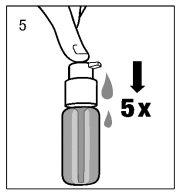
Дозированный раствор следует выбросить. В следующий раз, когда головка дозатора будет полностью нажата вниз (что эквивалентно одной пульсации), она уже будет дозировать правильную дозу (рис. 6).
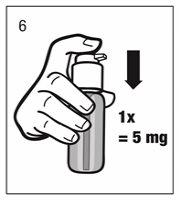

Правильное использование дозатора:
Поместите флакон на плоскую горизонтальную поверхность, например, на стол, и используйте его только в вертикальном положении. Поместите стакан с небольшим количеством воды или ложку под насадку. Нажмите головку дозатора вниз с силой, но спокойно, устойчиво и не слишком медленно (рис. 7 и рис. 8).
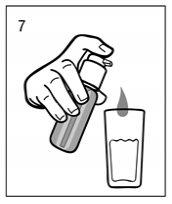

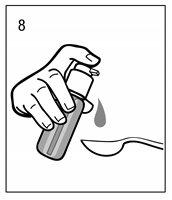

После этого головка дозатора может быть отпущена и будет готова для следующей пульсации.
Дозатор следует использовать только с раствором Мемантин Виатрис в предоставленном флаконе, а не для других продуктов или упаковок. Если дозатор не работает правильно, проконсультируйтесь с вашим врачом или фармацевтом. Закройте дозатор после использования Мемантин Виатрис.
- Страна регистрации
- Активное вещество
- Требуется рецептДа
- Производитель
- Информация носит справочный характер и не является медицинской рекомендацией. Перед приемом любых препаратов проконсультируйтесь с врачом. Oladoctor не несет ответственности за медицинские решения, принятые на основе этого контента.
- Аналоги МЕМАНТИНА ВИАТРИС 5 мг/доза ОРАЛЬНЫЙ РАСТВОРФорма выпуска: ТАБЛЕТКА, 10 мгАктивное вещество: memantineПроизводитель: Merz Pharmaceuticals GmbhТребуется рецептФорма выпуска: ТАБЛЕТКА, 10 мгАктивное вещество: memantineПроизводитель: Merz Pharmaceuticals GmbhТребуется рецептФорма выпуска: ТАБЛЕТКА, 20 мгАктивное вещество: memantineПроизводитель: Merz Pharmaceuticals GmbhТребуется рецепт
Аналоги МЕМАНТИНА ВИАТРИС 5 мг/доза ОРАЛЬНЫЙ РАСТВОР в других странах
Лучшие аналоги с тем же действующим веществом и терапевтическим эффектом.
Аналог МЕМАНТИНА ВИАТРИС 5 мг/доза ОРАЛЬНЫЙ РАСТВОР в Польша
Аналог МЕМАНТИНА ВИАТРИС 5 мг/доза ОРАЛЬНЫЙ РАСТВОР в Украина
Врачи онлайн по МЕМАНТИНА ВИАТРИС 5 мг/доза ОРАЛЬНЫЙ РАСТВОР
Консультация по дозировке, побочным эффектам, взаимодействиям, противопоказаниям и продлению рецепта на МЕМАНТИНА ВИАТРИС 5 мг/доза ОРАЛЬНЫЙ РАСТВОР – по решению врача и с учетом местных правил.











